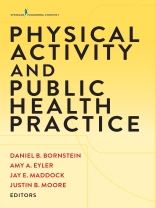Physical Activity in Public Health Practice provides the first evidence-based, practical textbook to guide readers through the process of conceptualizing, justifying, implementing, and evaluating physical activity interventions across a broad array of settings and populations. Section One begins with an overview of epidemiology, measurement, critical milestones, and the importance of moving beyond individual-level physical activity intervention, to interventions aimed at policy-, systems-, and environmental-level changes. Section Two considers planning interventions across a variety of settings and populations, including general concepts for implementation and evaluation, how to build effective coalitions, steps for developing community-, regional- or state-level strategic plans, and effectively translating policy into practice. Section Three addresses how to implement physical activity strategies across a variety of settings, including worksites, faith-based settings, healthcare settings, schools, and parks and recreation. This section also provides guidance on the complexities and challenges of targeting interventions for specific populations, such as families, older adults, persons with disabilities, as well as different strategies for urban and rural populations. Lastly, Section Four outlines effective strategies for how to evaluate interventions depending upon impact, outcome, and cost evaluation, and dissemination models for your intervention.
Presented from both a research and a practice perspective while discussing the best available research, this book provides the basis for planning and implementing physical activity programs that work and can build healthier communities. This hands-on text incorporates learning objectives, real-world examples, case studies, and bulleted lists whenever possible so that the content can be digested easily not only in undergraduate and graduate course settings but also by public health workers and other health educators in practice. Written by world experts and augmented by practical applications, this textbook prepares public health students and practitioners to develop effective interventions and spur greater physical activity in their communities.
Key Features:
- Provides effective strategies for properly measuring and increasing physical activity in communities
- Demonstrates how to carry out physical activity interventions across a variety of settings, including schools, communities, worksites and many more
- Discusses methods for directing physical activity interventions to specific populations
- Delivers strategies for building successful partnerships and coalitions
- Practical group activities, exercises, discussion questions, audio podcast discussions, and a full instructor packet accompany the textbook
Daftar Isi
Section One –An introduction to the science of physical activity and public health
Chapter 1: Physical Activity and Chronic Disease
Jonathan J. Ruiz-Ramie, Mark Sarzynski, and George L. Grieve
Chapter 2: Physical Activity Measurement and Sedentary Behaviors
John R. Sirard and Greg J. Petrucci, Jr.
Chapter 3: Important Milestones in Physical Activity and Public Health
Morgan Clennin and Daniel B. Bornstein
Chapter 4: Establishing the Value of Physical Activity for Different Stakeholders
Daniel B. Bornstein and Michelle M. Segar
Section Two – Planning your intervention
Chapter 5: Developing of Policy and Environmental Interventions
Amy A. Eyler
Chapter 6: Effective Strategies for Building and Maintaining Coalitions
Daniel B. Bornstein and Jay E. Maddock
Chapter 7: Developing Physical Activity Plans
Jay E. Maddock and Laura A. Esparza
Chapter 8: Physical Activity Policy to Practice
Amy A. Eyler and Laurie Whitsel
Section Three – Implementing interventions in Specific Communities and Settings:
Chapter 9: Physical Activity at the Workplace
Nicolaas P. Pronk
Chapter 10: Faith-Based Settings and Physical Activity Promotion
Benjamin L. Webb, Brook E. Harmon, and Melissa Bopp
Chapter 11: The Importance of the Healthcare Sector for Promoting Physical Activity
Mark Stoutenberg and Elizabeth A. Richards
Chapter 12: Physical Activity Promotion in Schools
Russell L. Carson, Jaimie Mc Mullen, Brian D. Dauenhauer, and Danielle R. Brittain
Chapter 13: Physical Activity Opportunities Outside of School
Angie Craddock
Chapter 14: Parks, Recreation, and Physical Activity
Morgan Hughey, Bianca Shulaker, Andrew Mowen, and Andrew T. Kaczynski
Chapter 15: Physical Activity and the Family
Joseph A. Skelton, Casey Foster, and Kaela Yates
Chapter 16: Best Practices for Ensuring a Healthy and Active Lifestyle in Older Adults
Marcia G. Ory, Barbara Resnick, Mark Stoutenberg, Aya Yoshikawa, and Matthew Lee Smith
Chapter 17: Physical Activity Practices for Individuals with Disabilities
Kiley J. Tyler
Chapter 18: Physical Activity in Urban Settings
Amy A. Eyler and William J. Davis
Chapter 19: Physical Activity in Rural Settings
M. Reneé Umstattd Meyer, Michael B. Edwards, Lindsay Elliott Jorgenson, and Justin B. Moore
Section Four – Evaluating Your Intervention
Chapter 20: Evaluation of Physical Activity Interventions: Impact, Outcome, and Cost Evaluations
Justin B. Moore, Jay E. Maddock, Camelia R. Singletary, and Theresa M. Oniffrey
Chapter 21: Implementation Monitoring for Physical Activity Interventions
Justin B. Moore and Theresa M. Oniffrey
Chapter 24: Dissemination: Models and Methods
Danielle E. Jake-Schoffman, Alicia A. Dahl, and Justin B. Moore
Tentang Penulis
Justin B. Moore, Ph D, MS, FACSM is an Associate Professor in the Departments of Family and Community Medicine, Epidemiology and Prevention, and Implementation Science at the Wake Forest School of Medicine in Winston-Salem, NC.












